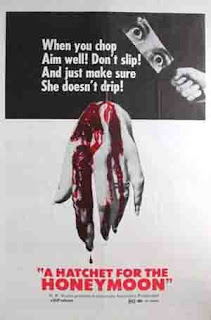The movie cuts quickly from the opening murder to a close-up of a toy train rattling along a track. Just as we are prepared to mock the movie for such obvious fakery, a hand reaches down and stops the train. The hand belongs to the killer from the opening sequence, and he commences with a voice-over.
"My name is John Harrington. I am a paranoiac. Hmm, paranoiac. An enchanting word, so full of possibilities. The fact is that I am completely mad. The fact remains that I have killed five young women."

This is the world of Mario Bava, the co-writer/cinematographer/camera operator/director whose movies embodied all the best elements of the Italian horror movie. Bava's movies, despite their pulp titles and plots and their commercial bent, were almost all intensely personal and distinctive. Hatchet for the Honeymoon is a good example of Bava's art, weaving a sophisticated and multi-layered story out of what would usually be handled as trash. The story is not the point here - it's all in how he handles it. This is pulp poetry of the highest order, and it would be much imitated in the subsequent decade, particularly in the movies of Dario Argento.
John Harrington is portrayed as a vain and shallow young man. At first he seems to be trapped in an unhappy marriage, with a shrewish older wife who refuses to give him a divorce. This rang alarm bells with me, with its misogynistic overtones, but Bava and his cast undermine these elements beautifully. We are given glimpses throughout that Mildred Harrington has been driven to this state by John's manipulative nature and inability to satisfy her.
John is driven by two of the great clichés of movie psychos: issues with his mother, and impotence. What makes this interesting is that, although this is obvious to the audience almost from the start, John himself is unaware of it and is in fact attempting to discover the roots of his own madness. Each time he kills John's memory opens up a little more, and he feels driven to keep killing until he has finally remembered what started him in the first place.
Hatchet for the Honeymoon is in essence a character study. Only one brief scene takes us away from John, so that just once we are left to wonder whether he has committed a murder or not. He is depicted from the beginning as vain and shallow, spending endless time on his appearance. He runs a fashion business specialising in bridal wear left to him by his mother, but Mildred's money bailed it out and it's only her that keeps it afloat (one of several instances where his wife is shown to be a mother substitute). All but one of his victims are all brides-to-be, so that he is always symbolically killing both his wife and his mother.
Then two things happen with unforeseen consequences. John meets a young woman called Helen Wood, and discovers he has actual feelings for her; and he finally kills his wife.
The scene where John kills Mildred is also the one where she is transformed into a sympathetic character. What leads him to kill her is not her mean-spirited comments, as she had displayed earlier in the movie, but her softening towards him. We discover that she really loves John and wants nothing more than for him to love her in return. The coldness in their relationship comes completely from him - they have never actually consummated their marriage because he is impotent. So John dresses as a bride himself, hacks her to death with a meat cleaver, and buries her in the hothouse.
However Mildred is not going to give up on him that easily. Wherever John goes from then on, people keep greeting his wife, asking her opinion, serving her drinks, and even having long conversations with her. They can see her. The camera can see her. But John cannot see her.

This is approach to a ghost story that I don't think I have ever seen before, and it's impressively handled. The movie puts us completely on Mildred's side, while allowing us to feel John's palpable fear at her presence - especially in the few instances when she allows him to see her, and one where she touches him. Bava's tricky camerawork allows her to appear and disappear without cutting, and Laura Betti's excellent performance as Mildred makes these scenes extremely memorable.
After she appears to him and tells him that she will never leave his side, John attempts to exorcise Mildred by digging up her body and cremating her in the furnace. He carries her ashes around with him in a satchel, as a sick joke, but instead of the satchel people continue to see Mildred. It doesn't matter if he throws away the satchel and scatters the ashes - it keeps returning to him.
Meanwhile Helen is pushing John for a sexual relationship, and as for him sex means murder he is unwilling to commit to someone he actually cares for. At the same time a police inspector keeps dropping around to talk to him, obviously thinking that John is the prime suspect (several of the victims were models working for him) and trying to work on his mind in the absence of any physical evidence. The scene where the inspector almost catches John killing Mildred milks it for suspense in a manner that rivals the best of Hitchcock.
The final revelation is not a surprise to the audience, and the final scene - where Mildred gets the last laugh - is also predictable but still extremely satisfying.
This is an excellent thriller, provided you don't mind the end being so predictable. Bava's visual tricks are all tied into exploring character - the uses of many mirrors and reflecting surfaces, for example, or his characteristic use of the zoom to highlight irony. It would not be a bad introduction to Italian horror in general.


No comments:
Post a Comment